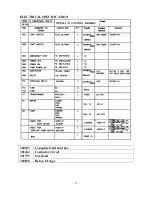
- 9 -
TOOTH
SELECTION
You need to consider:
1. The width of the cut. That is, the distance in the cut that each tooth must travel from the point it
Enters the work piece until it leaves the work piece, and
2.The shape of the work piece.
Squares, Rectangles, Flats (Symbol :
)
Locate the width of cut on the chart. (Inches on the outer circle and millimeters on the
inner circle.) Select the tooth pitch on the ring marked with the square shape which aligns
with the width of cut.
EXAMPLE: 6" (150mm) square, use a 2/3 Vari-Tooth.
Round Solids (Symbol :
)
Locate the diameter of your work piece on the chart. Select the tooth pitch on the ring
marked with the round shape which aligns with the size of stock you are cutting.
EXAMPLE: 4" (100mm) round, use a 3/4 Vari-Tooth.
Tubing, Pipe, Structurals( Symbol : O H ^ )
Determine the average width of cut by dividing the area of the work piece by the distance
the saw blade must travel to finish the cut. Locate the average width of cut on the chart.
Select the tooth Ditch on the ring marked with the tubing and structural shape which
aligns with the average width you are cutting.
EXAMPLE: 4"(100mm) outside diameter, 3"(75mm) inside diameter tubing.
4"(100mm) OD =12.5 sq.ln. (79cm
2
)
3"(75 mm) ID = 7.0 sq.ln. (44cm
2
)
Area = 5.5 sq.ln. (35cm
2
)
5.5 sq.ln. (35cm
2
) / 4" (100mm) distance =1.38(35mm) average width
1.38" (35mm), use a 4/6 Vari-Tooth
NOTE: The band speed and cutting rate recommendations presented on this chart are
approximations and are to be used as a starting point for most applications. For exact
sawing parameters' consult your saw blade supplier.
Содержание SE-912
Страница 23: ... 23 ELECTRICAL SPECIFICATION ...
Страница 24: ... 24 ...
Страница 25: ... 25 ...
Страница 26: ... 26 ...










































